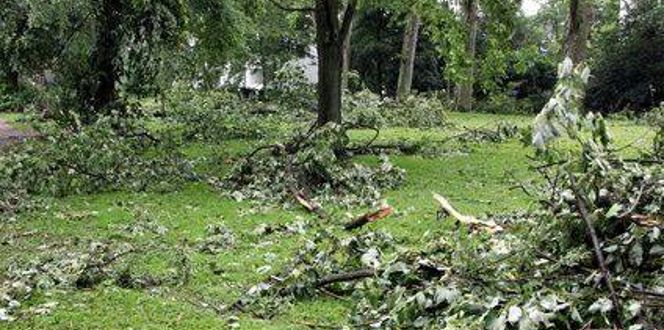As trees grow, some of their branches can become heavy. . 0r grow with weak attachment points.
Trees like sugar maples are known for their big heavy branches that rarely break, but other trees like beeches or red maples can break under heavy loads like snowfall.
By easing the load on these limbs with tree limb supports, you help reduce the risk of causing any property damage and extend your tree’s health.
Let’s talk about the best cabling or wiring to support tree limbs and how to support drooping inner tree limbs so you can protect your tree and your property from any future damage.
Common Structural Defects In Trees
To understand how to support heavy limbs on trees, it’s crucial to get a sense for the common structural defects trees might have that can lead to the need for additional support.
Some typical areas that can be concerning include:
- Dead, diseased, dying, or broken branches that result from poor growth, storms, or pest activity. These may need to be removed or pruned and may not be candidates for additional support, depending on the issue. A certified arborist will be able to assess this for you.
- Thinning or poor canopy health from environmental stressors or pest activity. An unbalanced or sparse canopy produces dead and overly-exposed branches.
- Unstable branching patterns with overextending or weakly attached branches which cannot be simply removed or reduced through pruning.
- Minor cracks or seams through the bark and into the tree’s wood as a result of lightning or splitting from weather-related instances.
Types Of Tree Support Systems
There are quite a few tree limb supports that can be used to assist leaders, individual branches, or entire trees.
Proper support for tree limbs can limit the movement of branches, leaders, or even whole trees where necessary.
Cabling
Tree limb support cables help restrict the distance a branch or codominant stem can move in relation to the rest of your tree. This prevents them from bending to the point where they break.
You might see cables used to support a weak fork and reduce the risk of a branch breaking. Cabling is also helpful for supporting overextended branches.
When it comes to how to use cabling to support tree limbs, a certified arborist will assess your tree and determine how many cables are necessary or if brace rods must be used with the cables. He or she will also determine the correct point at which the cable will be most supportive, If you are getting a lightning protection system as well, the cable system components will all be connected to this system.
Brace Rods
A certified arborist may use brace rods as tree supports when your tree has multiple leaders with a weak attachment point.
The rods help reduce the risk of the leaders spreading and breaking apart. Brace rods are also helpful in some cases to repair an already separated fork or split branch.
Brace rods are installed with at least one cable above for added support. These decisions are based on tree size, structural issues, and any present decay.
Tree Stakes
A bit different than brace rods and cables, tree stakes are used to hold your newly-planted or moved tree upright and keep the rootball in place until it establishes itselfin the surrounding soil.
Most of the time, certified arborists discourage staking because trees with adequate root systems don’t need staking at planting and need to be able to flex some in the wind to establish good stem taper and strength. However, staking can be a helpful tree support system for trees planted on steep slopes and in loose soil or for those that have top-heavy, large crowns. Some slack is incorporated into systems to encourage some movement and stimulate stronger stem growth.
After staking, a certified arborist will regularly inspect and adjust the stakes to prevent damage to the tree and remove them as soon as the tree is stable on its own.
Why You Should Hire An Arborist
No one wants their beloved tree to become a risk with heavy branches that can cause concern.
Poorly executed tree care or the lack of adequate care can lead to some of the defects that result in weak branches or the need for tree limb support.
Certified arborists are able to provide tree health and risk assessments to help identify defects before they become major problems. They can design and install an appropriate system for your tree and provide ongoing inspections and maintenance. Spotting tree defects can be a complicated job that requires training and experience, and catching these problems early can save you money and prevent potential damage or tree loss.







